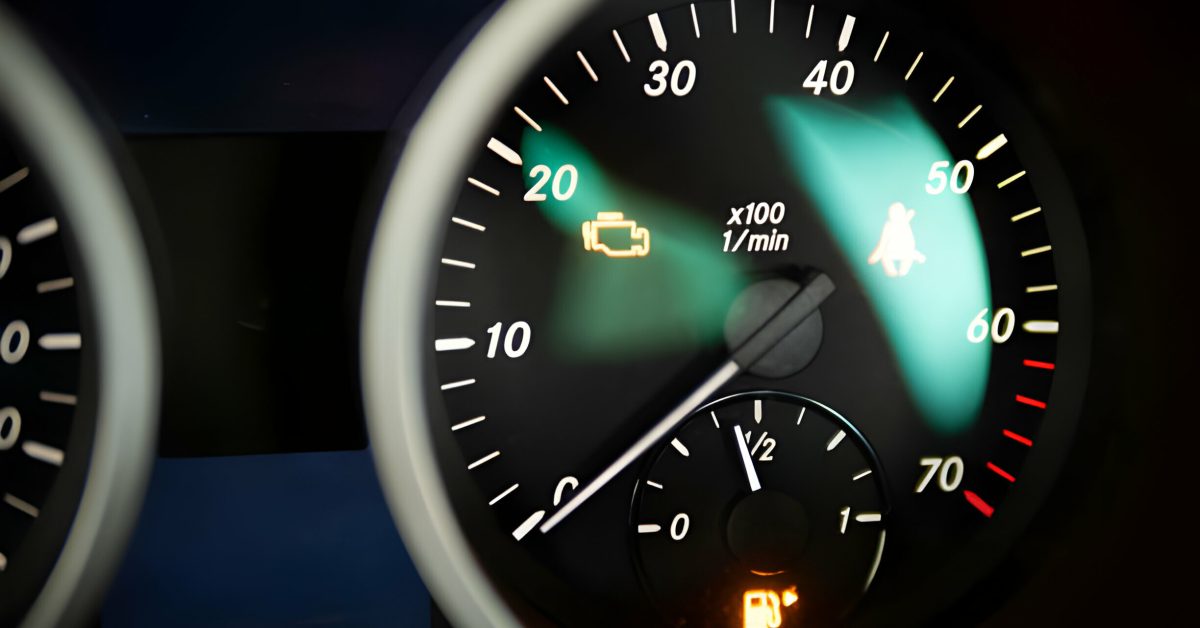When your check engine light suddenly appears on the dashboard, it’s more than just a mild inconvenience, it’s your car’s way of warning you that something could be wrong. Whether it’s a loose gas cap, a faulty oxygen sensor, or catalytic converter issues, the light can be triggered by a wide range of common culprits. Understanding what your engine light means, and knowing what steps to take next, can help prevent more serious damage and costly repair bills.
In this guide, we’ll walk you through everything from reading diagnostic trouble codes using an OBD II diagnostic tool, to recognizing signs like rough idle, engine misfires, or a flashing check engine light—all of which could point to problems with your fuel injectors, mass airflow sensor, spark plugs, or other essential components. If you’re not sure where to start, or if check engine light ignoring has already led to bigger problems, we’ll also explain when to stop driving and call a qualified mechanic for a full engine diagnostic service.
Let’s break down what your on board diagnostics system is really telling you, and how to diagnose, determine, and ultimately fix the root cause before it affects the rest of your vehicle.
Understanding the Check Engine Light and Diagnostic Trouble Codes
When the check engine light illuminates on your dashboard, it’s akin to your vehicle’s way of saying, “I need some attention.” But what is an engine light, and why does it matter so much? This guide demystifies the check engine light, helping you understand its importance and what it signifies about your vehicle’s health.
What Is the Check Engine Light and Why Engine Diagnostic Service Matters
At its core, the check engine light is a signal from your car’s onboard diagnostics system (OBD) indicating that something is amiss. It could be as minor as a loose gas cap or as serious as a malfunctioning engine component. Regardless, it’s a call to action not to be ignored.
Common Causes Behind a Check Engine Light
Understanding why your check engine light is on is the first step towards addressing any potential issues. Here are a few common culprits:
- Faulty Oxygen Sensor: This sensor monitors how much fuel is burned. A malfunction can decrease fuel efficiency and increase emissions.
- Loose or Faulty Gas Cap: A small issue like a loose gas cap can trigger the light, as it affects the fuel system pressure.
- Catalytic Converter Failure: Essential for reducing exhaust gases, a failing catalytic converter can lead to decreased performance and fuel economy.
- Spark Plug/Ignition Coil Issues: These components are vital for engine performance. Problems here can cause the engine to misfire.
- Mass Airflow Sensor (MAF) Problem: This sensor measures the amount of air entering the engine, influencing its efficiency. A malfunction can affect the engine’s performance.
Each of these issues can lead to the question, “Why is my engine light on?” Recognizing the symptoms early can prevent more significant problems down the road.
Understanding your check engine light’s signals is crucial for maintaining your vehicle’s health and ensuring it operates smoothly. Ignoring this light can lead to more severe problems, affecting your car’s performance and possibly leading to costly repairs.
How a Faulty Oxygen Sensor, Catalytic Converter Issues, and Other Problems Trigger the Light
When the check engine light turns on, it’s natural to feel a mix of confusion and concern. How to check why my engine light is on becomes a pressing question. Fortunately, diagnosing the cause is more straightforward than you might think, thanks to modern automotive technology.
How to Check Why Your Engine Light Is On Using a Diagnostic Tool
The first step in diagnosing your vehicle’s check engine light is to use an OBD-II scanner. This tool is indispensable for car diagnostics and can be purchased or borrowed from many automotive stores. Here’s a basic step-by-step guide:
- Locate the OBD-II Port: Typically found under the dashboard near the steering wheel.
- Connect the OBD-II Scanner: Plug the scanner into the port.
- Read the Diagnostic Trouble Codes (DTCs): Turn on the scanner and your vehicle (in some cases, you might not need to start the engine). The scanner will read the car’s computer and display one or more codes.
- Interpret the Codes: Each code provides information about the type of issue detected. You can look up these codes in the scanner’s manual or online to understand the specific problems.
Interpreting Diagnostic Trouble and What It Means for Your Vehicle
While an OBD-II scanner provides a starting point, understanding the nuances of diagnostic codes and what they signify is crucial. Sometimes, a single code can have multiple underlying causes, necessitating further investigation.
- Professional Diagnostic Check: If you’re unsure about the meaning of the codes or how to address the issues, seeking professional help is advisable. Many automotive repair shops, including those specializing in engine diagnostics, offer comprehensive checks. They use advanced diagnostic tools and their expertise to pinpoint the exact problem.
- DIY Troubleshooting: For those with some mechanical knowledge, simple issues like checking for a loose gas cap or examining the condition of spark plugs can be a starting point. However, more complex problems require professional attention to avoid further damage to your vehicle.
Flashing Check Engine Light? Here’s What to Do Immediately
Knowing how to check your engine light and understanding the diagnostic codes is more than just a technical exercise. It empowers you as a vehicle owner to make informed decisions regarding the maintenance and repair of your car. It also helps you communicate more effectively with automotive professionals when seeking repair services.
Remember, while an OBD-II scanner can tell you what code is causing the check engine light to come on, it doesn’t always tell you how to fix the problem. That’s where the expertise of a trusted mechanic or a visit to a reputable repair shop like Metric Motors becomes invaluable.
What to Do About Engine Misfires and Other Critical Warnings
Seeing the check engine light come on can be unsettling, but it’s crucial to approach the situation calmly and methodically. Here’s what you need to do:
Immediate Steps to Take
- Check for Serious Problems Immediately: If the check engine light is flashing, this indicates a more severe issue, such as a misfiring engine that can cause damage over time. Reduce speed and load on the engine, and seek professional assistance as soon as possible.
- Ensure It’s Not a Loose Gas Cap: A common and easily fixable issue is a loose gas cap, which can trigger the check engine light. Check if the cap is loose or damaged, and tighten or replace it as needed.
- Use an OBD-II Scanner if Available: For a preliminary diagnosis, use an OBD-II scanner to read the error codes. This step can give you a general idea of what’s wrong.
What to Do About the Check Engine Light in Different Scenarios
- If the Light Stays On and Is Steady: This usually indicates a less urgent issue. However, it shouldn’t be ignored. Plan to check the vehicle with a professional soon.
- If the Light Is Flashing: This signals a severe problem that needs immediate attention to prevent damage to the vehicle. It’s best to minimize driving and get the car checked at the earliest convenience.
- After Addressing the Issue: Once you’ve fixed the issue causing the check engine light to come on, the light should automatically turn off. If it doesn’t, a visit to a professional may be necessary to reset the car’s computer system.
Why Catalytic Converter Problems Shouldn’t Be Ignored
While the steps above can help you initially handle a check engine light situation, a professional diagnosis is crucial for several reasons:
- Accuracy: Professionals have the experience and tools to accurately diagnose the problem, ensuring that the right repairs are made.
- Safety: Some issues indicated by the check engine light can pose safety risks if not addressed promptly.
- Cost-Effectiveness: Early detection and repair can prevent more significant, costly problems down the line.
When to Seek a Professional Engine Diagnostic Service
After diagnosing the issue, depending on the severity, you may choose to address it immediately or plan for repairs. In either case, ensuring that your vehicle receives the attention it needs is vital for maintaining its health and performance.
Remember, the check engine light is a critical component of your vehicle’s onboard diagnostic system. It serves as an early warning system for potential problems, helping you avoid more significant issues down the road.
Preventive Maintenance Tips to Avoid Common Causes of Engine Trouble
Preventing check engine light issues before they start is key to maintaining your vehicle’s health and avoiding unexpected repair costs. Here are some tips to keep your car running smoothly:
- Regular Maintenance: Follow your vehicle’s maintenance schedule for oil changes, filter replacements, and other routine services.
- Keep an Eye on the Dashboard: Pay attention to any alerts or warnings on your dashboard, not just the check engine light.
- Address Issues Early: Don’t ignore minor problems. Small issues can escalate into more significant, costly repairs if left unattended.
- Fuel Cap Check: Ensure your fuel cap is secure and undamaged after every fill-up to avoid triggering the check engine light unnecessarily.
- Use Quality Parts: When repairs are needed, opt for quality parts that meet or exceed your vehicle manufacturer’s specifications.
Following these tips can help extend the lifespan of your vehicle and improve its performance, ensuring a smoother and more reliable driving experience.
Don’t Ignore Your Check Engine Light—Act on Diagnostic Trouble Codes
The check engine light is more than just an indicator; it’s a crucial warning system that shouldn’t be ignored. Whether it’s a minor issue like a loose gas cap or something more serious, addressing the problem promptly can save you time and money in the long run. Understanding what to do when this light comes on and where to get help is essential for every vehicle owner.
If your check engine light is on and you’re unsure what to do, don’t wait for the issue to escalate. Contact us at Metric Motors for a comprehensive diagnostic check. Our team of experienced professionals is equipped to diagnose and fix any problem, ensuring your vehicle is safe and road-ready. Trust us to provide the quality service and peace of mind you deserve. Schedule your appointment today and let us take the worry out of your check engine light concerns.
Final Thoughts: Don’t Delay Your Diagnostic Scan
When warning lights appear, whether it’s due to a faulty sensor, vacuum leak, rough idle, or low oil, they’re alerting you to issues that can affect key engine components like the cylinder, wiring, or other parts. While many vehicles let drivers use a basic scan device for a quick report, a professional engine diagnostic service offers deeper insight.
A diagnostic scan can detect many issues, from a faulty battery to subtle performance problems. Acting early helps you access the right fix before bigger damage occurs. If your check engine light is on, don’t ignore it, get it checked and stay ahead of costly repairs.





